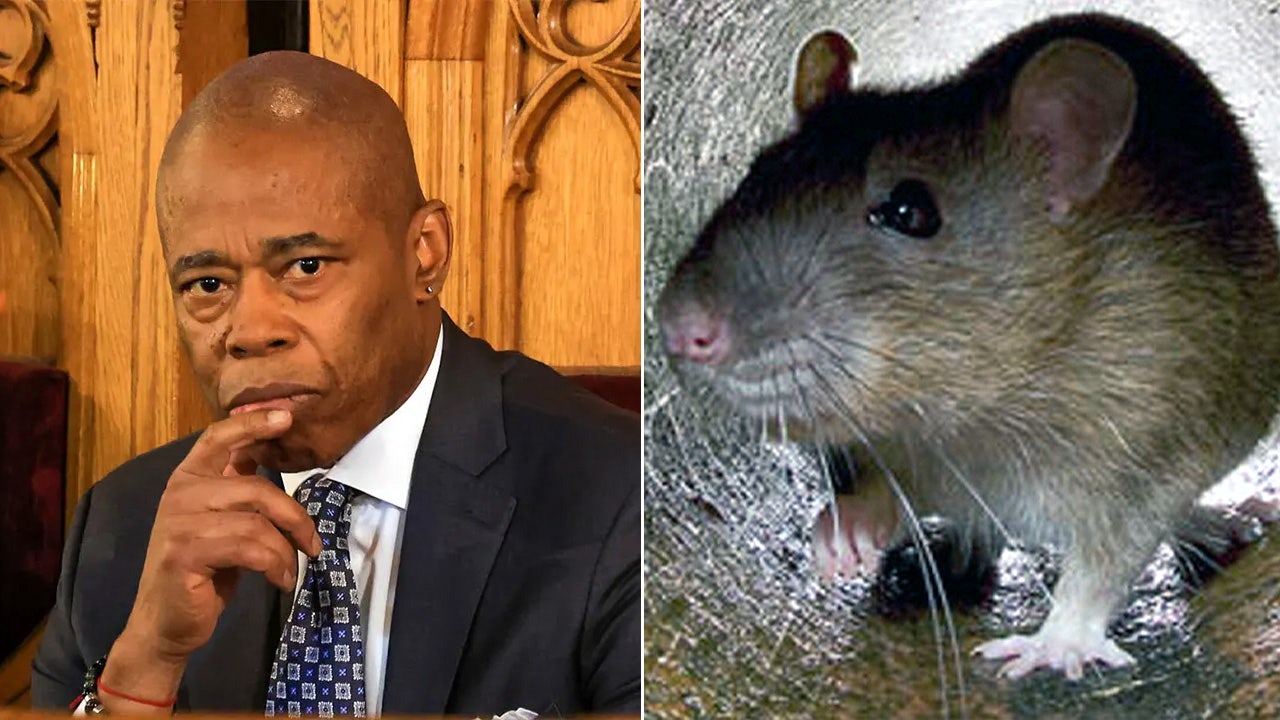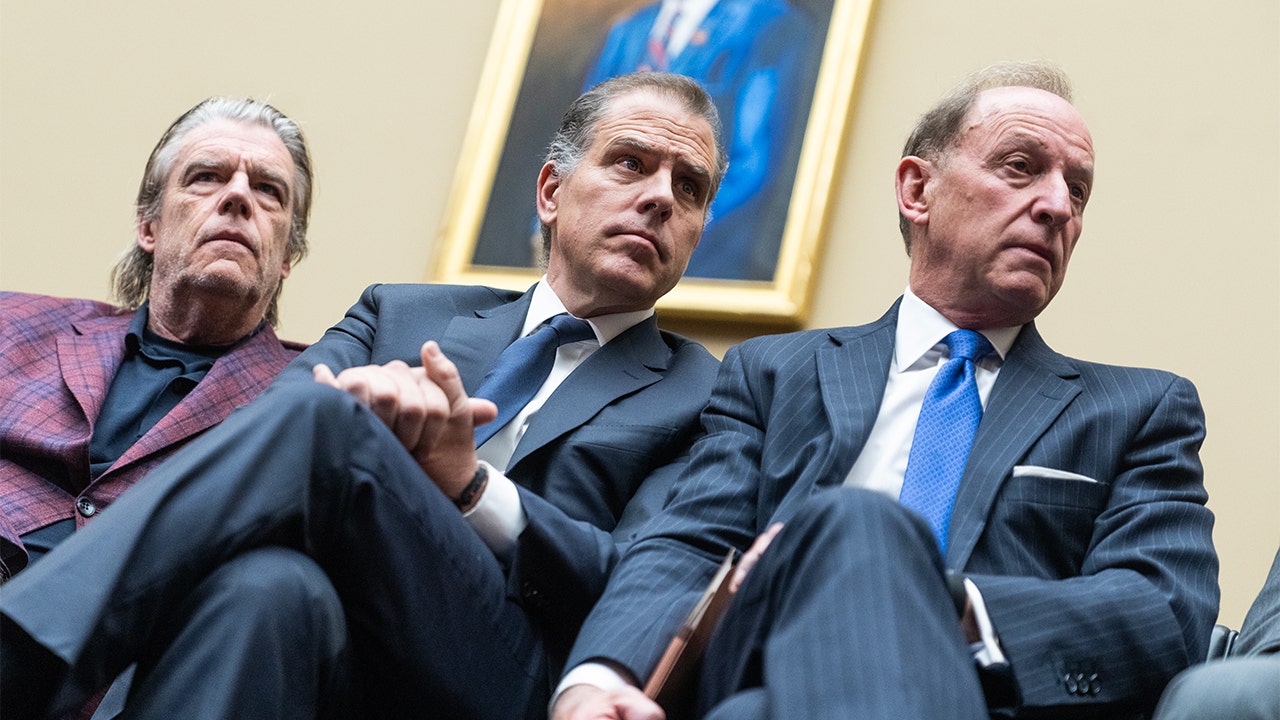Sports
Amid Lakers coaching speculation, Clippers hope to keep Tyronn Lue for a 'long time'
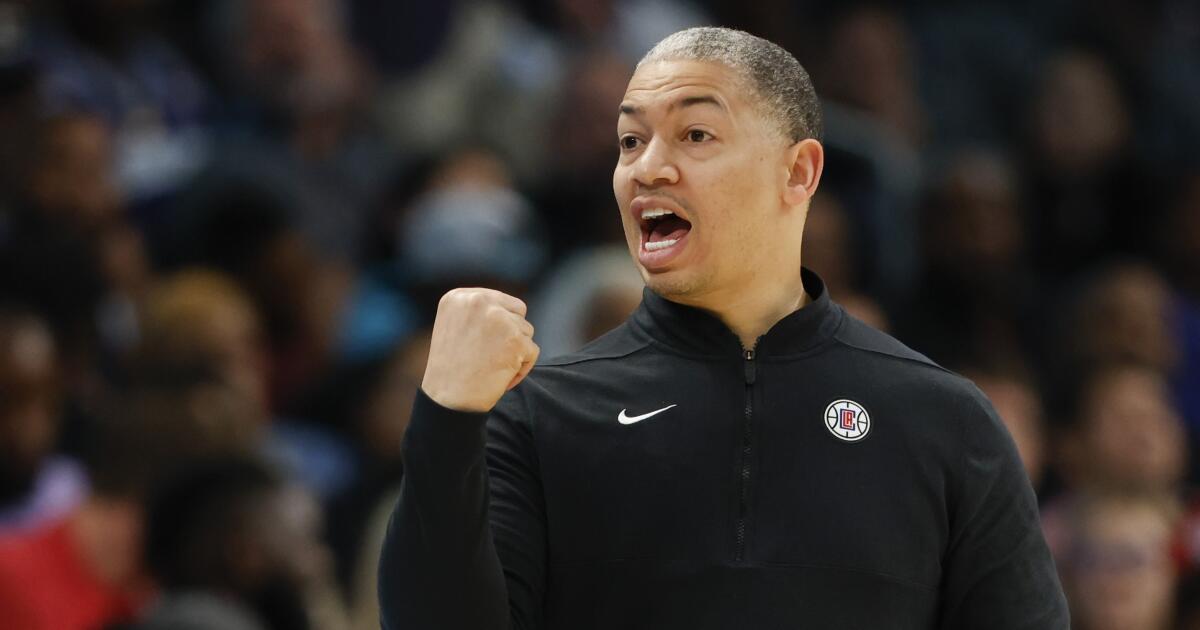
The Clippers expect Tyronn Lue to be the coach of the team for a “long time” and the plan is to offer him a contact extension so he’s not coaching the 2024-25 season in the final year of his deal, according to a person with knowledge of the situation not authorized to speak publicly on the matter.
The subject of Lue and an extension came up after the Lakers fired Darvin Ham on Friday and the Clippers coach’s name came up as a possible candidate for them and other openings that might come up. Also, Lue and LeBron James won a championship together in Cleveland in 2016 and the two still have a strong relationship, the person said, citing another reason why there is talk the Lakers would be interested in Lue if he becomes available.
Lue’s contract for next season is a team option and is partially guaranteed, according to one person. But there have been no talks about an extension, the person said.
The Clippers gave Kawhi Leonard a three-year contract extension for $150 million that starts next season as well as the team looking to extend Paul George and re-sign James Harden this summer.
Lue, who turns 47 Friday, was offered the Lakers’ job in 2019, but the sides couldn’t agree on a deal, leading the team to hire Frank Vogel. Lue became the Clippers head coach for the 2020-21 season and led them to the franchise’s first-ever Western Conference finals in 2021.
Despite many injuries, Lue has taken the Clippers to the playoffs in three of the four seasons he has been the coach.
The Clippers are down 3-2 to the Dallas Mavericks in a first-round series, with Game 6 Friday night at American Airlines Center.
Leonard will not play because of inflammation in his right knee that now will have kept him out of four of the six playoff games.
Leonard missed the final eight regular-season games because of the knee issue, but Lue still directed the Clippers to the fourth seed in the rugged Western Conference with a 51-31 record.
Lue has a 321-212 record over his eight years as a head coach in the NBA and is considered one of the best in the game.

Sports
How the House v. NCAA settlement could reshape college sports: What you need to know

Big 12 presidents and chancellors voted to approve proposals of what is expected to be a multi-billion dollar settlement in the House v. NCAA class-action lawsuit Tuesday, a source briefed on the decision confirmed to The Athletic. Their approval is another step toward a resolution in the landmark case likely to reshape the college sports business model.
The Big 12 is the first of the suit’s defendants to vote on the settlement terms, with the remaining power conferences and NCAA Board of Governors also expected to do so this week. It’s expected the settlement will cost them nearly $3 billion in damages and allow power-conference athletes to finally share in annual revenues.
House v. NCAA seeks back pay for Division I college athletes who were barred from earning name, image and likeness (NIL) compensation prior to the NCAA changing its policy in summer 2021, while also pursuing a cut of future broadcast revenues for athletes at power-conference schools.
As college sports face a reckoning on multiple fronts, and with the prospect of the NCAA owing as much as $20 billion in damages were it to lose the House case at trial, settlement efforts intensified in recent weeks.
In addition to more than $2.7 billion in NIL back-pay damages, a settlement would include a system in which roughly $20 million a year can be distributed directly from a power-conference school to its athletes, multiple people briefed on the negotiations confirmed to The Athletic.
All indications are that the last vestiges of amateurism in college sports are coming to an end.
“I expect the athletes who are generating the most money would get the greatest economic return,” said Jeffrey Kessler, one of the lead lawyers representing the plaintiffs. “That’s the economic competitive market we live in.”
A House settlement would be the next legal domino in what has been a busy stretch of forced change for the NCAA, including the U.S. Supreme Court unanimously upholding the NCAA v. Alston decision in 2021 and agreeing that the NCAA’s cap on education-related expenses was an antitrust violation. State legislatures helped usher in the NIL era weeks later. Lawsuits filed by multiple state attorneys general have since forced the NCAA to halt enforcement of NIL regulations and allow multi-time transfers immediate eligibility.
Over the past three years, these lawsuits and policy changes have created (and exposed) cracks in the foundation of the collegiate model.
GO DEEPER
Why is the NCAA proposing a new subdivision? Explaining the related legal battles
“The most important part about the settlement — and let’s face it, there’s still a lot of work to be done there — is it creates some clarity and some visibility on a whole bunch of issues that have sort of been roiling everybody for a while,” NCAA president Charlie Baker said last week. “The other thing it does is create predictability and stability for schools. It creates a tremendous opportunity for student-athletes.”
So what does this mean for fans of college sports? Most immediately, it simply means that the power-conference programs you follow and root for, which bring in millions of dollars in revenue annually from television contracts and ticket sales, can start paying athletes with that money — a significant budgetary adjustment, but not so functionally different from how school-affiliated NIL collectives have started paying players.

GO DEEPER
College football portal confidential: How tampering, NIL deals and portal chaos happen
Yet in the broader scope, this settlement will further widen the gap between high-major revenue sports — particularly power-conference football — and the rest of college athletics. It’s another step toward a future in which the biggest programs stratify or fully separate from the rest of the NCAA into some version of super conferences or a super league. To that end, there’s also been some organized, internal pushback within the NCAA from smaller Division I conferences that believe they will be forced to shoulder a disproportionate amount of the damages in the proposed settlement.
Plenty of hurdles remain beyond the House case as well, including whether athletes will ultimately unionize and/or be deemed employees, or if the NCAA can secure antitrust exemptions from Congress. Regardless, big changes are on the horizon, and in a way the NCAA has long fought.
Here’s more on what’s at stake in House v. NCAA, and what could come next.
Potential settlement details
The NCAA is backed into a corner.
House v. NCAA was filed in June 2020 with Grant House, a former Arizona State swimmer, and Sedona Prince, a former Oregon and current TCU women’s basketball player, as the two named plaintiffs. In November, U.S. District Court Judge Claudia Wilken, who has a track record of ruling against the NCAA in similar cases (O’Bannon, Alston), granted class-action certification for the damages portion of the House case, expanding it to any Division I athlete dating back to 2016 (in accordance with a four-year statute of limitations).
This exponentially elevated the potential cost — and impact — of the case, which is currently scheduled to go to trial in January 2025.
U.S. antitrust laws grant plaintiffs three times the damages they are awarded — known as “treble damages” — meaning if the NCAA lost at trial, it would automatically be on the hook for triple the damage amount ordered by the judge. According to documents circulated among power conference presidents and administrators and obtained by Yahoo Sports, that final class-action figure could be as high as $20 billion, and enough to force the NCAA to file for bankruptcy.
A loss at trial would also strike down any existing constraints on NIL.
“So essentially, if we win, there would be a complete free market in NIL, including from broadcast payments,” said Kessler.
The combination of triple damages, which would likely have to be paid out immediately, and the NIL floodgates fully opening would be a death rattle for the NCAA, and why a settlement is seen as the surest path to the organization’s survival, at least in the short term.
Through a spokesperson, the NCAA declined to comment.
Certain details of the settlement, though not finalized, have been reported by multiple outlets and confirmed to The Athletic. The nearly $3 billion in back-pay damages would be paid out over 10 years, and power-conference programs could opt into the annual $20 million revenue-sharing allocation likely starting with the 2025-26 season.
This would coincide with a change in roster limits that would eliminate existing caps on scholarships, such as a baseball team’s 11.7 scholarships that get divvied up among 30-plus players. If the baseball roster limit was set at 25, for example, schools would have 25-player teams and could fully fund up to 25 scholarships. This impacts football as well, where teams currently have 85 allotted scholarships but can carry up to 115 total players on the roster. There’s fear among coaches that the new roster limit could eliminate walk-ons.
“Our game is not the pro game,” said Wake Forest coach Dave Clawson, a member of the American Football Coaches Association board. “We get players that need to be taught and coached when they come out of high school. …(In the NFL), they have a practice squad, they have access to players and other teams. Once we start practice, our roster is set for the year, and they have to be students.”
ACC commissioner Jim Phillips said those roster determinations would be “local decisions” for each university, with better-resourced schools likely to do more than others within the Power 4 leagues. Roster limits are expected to be part of Thursday’s vote by the conferences, and multiple administrators told The Athletic that they expect specific scholarship figures to be decided collectively by the Power 4 conferences in the coming months.
What the NCAA could avoid with a settlement
The compromises of a possible House settlement are obvious, but so are the benefits. The NCAA doesn’t risk the immediately payable treble damages at trial and can negotiate terms on a revenue-sharing model while maintaining a similar operating structure.
College athletes receive scholarships and other benefits, but the anticipated rate of revenue sharing wouldn’t be nearly as high as their counterparts in the pros. The roughly $20 million annual amount represents 22 percent of the average Power 4 school’s annual revenue. Revenue sharing in the major American professional sports is usually around 50 percent for the players.
A settlement would also address another major NCAA issue by simultaneously resolving other high-profile antitrust cases, including Hubbard v. NCAA and Carter v. NCAA; plaintiffs in both cases are also represented by Steve Berman and Kessler.
Hubbard is similar to House in the sense that it is seeking retroactive damages for education-related Alston payments; Carter argues that rules prohibiting college athletes from receiving “pay for play” violate antitrust law. A House settlement would resolve each of them.
One other antitrust case factors in: Fontenot v. NCAA, a separate, class-action suit filed in Colorado that is seeking similar claims and damages as Carter. A motion to transfer the case to the same Northern District of California court as the other antitrust suits has been requested, ostensibly to have it resolved by a settlement in the House case. A hearing on the transfer is also set for Thursday.
Resolving all four antitrust cases — House, Hubbard, Carter and Fontenot — is a crucial aspect of the settlement for the NCAA, according to people briefed on the negotiations.
“In the current world we live in, planning is very hard to do,” Baker said. “If we can land this thing … I think it creates a lot of stability and clarity for schools. And it makes it possible for all of us to start thinking about what the next act will look like as it rolls out instead of feeling like you’re waiting for the next shoe to drop.”
How it would work
Assuming the NCAA and power conferences sign off on terms this week, there would still be a number of steps to complete a settlement, including official filing, an approval from Judge Wilken and a 90-day period for review and any objections.
If approved, the power-conference revenue sharing will be optional, and there are no specifications on how the money will be distributed, as long as it stays within the capped allotment.
It’s expected that most if not all power-conference programs will opt in to some degree of revenue sharing in order to remain competitive. But even for a number of the schools at that level, it could be a gradual financial process that requires cuts elsewhere.
“As it currently stands, I don’t know many schools that will be able to pay even remotely close to ($20 million) without eliminating some portion of what they currently spend,” said Iowa State athletic director Jamie Pollard.
For back-pay damages, the NCAA would use its reserves to cover $1.1 billion, and the remaining approximately $1.6 billion would come from withheld revenue distributions, chiefly via the NCAA men’s basketball tournament credits. Of that $1.6 billion, nearly 60 percent is expected to come from leagues outside the Power 4 conferences (including the Group of 5), according to people familiar with the settlement proposal.
The 22 smaller, non-FBS conferences (colloquially referred to as the CCA22) were not initially briefed on the settlement talks until earlier this month, multiple administrators said, once the financial structure of payouts had already been formulated.
One Division I commissioner estimated that non-FBS conferences would be on the hook for $2.5 million per year to help cover the NCAA’s costs of the settlement. Two sources in different CCA22 leagues said that equates to roughly 25 percent of the annual revenue those schools receive from the NCAA. That level of reduction could lead to cutting sports and athlete resources, despite a lawsuit that was clearly aimed at power-conference schools with the most lucrative media deals.
“The burden that’s being pushed to us is not following any sort of logic as it relates to the court order,” one non-Power 4 source said.
However, the damages payment model that is being voted on is a slightly tweaked version of the original breakdown put forth by the NCAA, a college administrator briefed on the proposal told The Athletic. That’s despite the non-FBS leagues submitting a formal request to the NCAA’s Board of Governors and Division I Board of Directors on Monday, according to sources briefed on the proposal, asking to either delay a final decision on the financial breakdown or adjust it to an equivalent rate of revenue reductions for each conference. The latter would have made the power conferences responsible for roughly 60 percent of the damages.
The Board of Directors and Board of Governors (the NCAA’s highest governing body) are also scheduled to vote on settlement details this week, including authorizing the NCAA to use its financial reserves.
Another area to be addressed is how the terms of a settlement apply to the new classes of athletes each year. Berman mentioned a potential solution.
“Every year, when an NCAA athlete reports in to start the year, they could be given a copy of the class notice and the settlement, and given an opportunity to object within a few months receiving that notice,” said Berman.
Jim Cavale, the founder of the players organization Athletes.org, questions the forward-looking part of the settlement, saying it lacked athlete input. His organization includes about 1,500 power-conference athletes and recently signed up the entire UAB football team.
“How involved are the current athletes?” he said. “On top of that, how involved if at all are future athletes on these terms? The answer is not at all. The results of a (collective bargaining agreement), the terms of the athlete experience and even these caps are not really the responsibility of these plaintiffs’ lawyers in a class-action lawsuit.”
Some industry sources believe there could be less incentive or motivation for players to unionize once they’re getting a piece of the pie. Cavale disagrees.
“Should it be approved, if we got 500 of our 3,000 athletes to object, the way it’s written, you’re going to have 500 different hearings,” he said.
Other unknowns
Plenty more questions remain.
• How will Title IX apply to revenue-sharing distributions? Will proportional payments need to be made to male and female athletes in order to remain compliant — meaning an athletic department can’t spend all or most of its revenue-sharing dollars on football or other men’s sports — or would schools argue that proportional scholarship opportunities satisfy Title IX? This is not something that can be stipulated by the settlement and could be challenged in court. Multiple administrators at Power 4 schools told The Athletic they believe the total dollar figure needs to be equal between male and female athletes, but that their understanding is that each school can determine how to allot the money between its athletes and sports.
• How would this impact potential unionizing and collective bargaining ventures?. Unionizing efforts by the Dartmouth men’s basketball team and national advocacy organizations such as Cavale’s Athletes.Org and the College Football Players Association have yet to gain widespread support, a challenge within something as wide-ranging and transient as college sports. But the topic could receive renewed attention in the wake of a settlement, along with the ongoing discussion of whether college athletes should be deemed employees, which is at the heart of both the Johnson v. NCAA suit and a National Labor Relations Board complaint against USC, the Pac-12 and the NCAA.
In any event, settling House and resolving the other prominent antitrust lawsuits will not fully shield the NCAA from future legal battles, which is why Baker and the organization will continue to pursue Congressional antitrust exemptions.
“(A settlement) creates a framework that makes it possible to then have a different kind of conversation with Congress,” said Baker. “So, in many ways, I’m hopeful.”
• What about NIL collectives? A settlement wouldn’t fully address the role of these third-party organizations and the culture of pay for play, though Yahoo Sports reported that the informational documents it obtained mentioned “economic incentives” for athletic departments to bring collectives in-house.
• How will the financial adjustments trickle down? Will schools decide to cut athlete benefits, administrative positions or entire sports? Will this finally stem the tide of ballooning, seven-figure annual coaching salaries, bloated staffs and multi-million-dollar buyouts? Wholesale changes to the structure of collegiate athletics and the NCAA’s governance remain likely years away, but that doesn’t mean reverberations won’t be felt sooner in other areas.
“It could be the sports you sponsor,” Pollard said. “It could be what you do for the sports you sponsor. It could be the number of staff you have in football. It could be the number of players you have on a football team. Everything’s going to be on the table.”
—The Athletic’s Chris Vannini and Scott Dochterman contributed reporting.
(Photo Illustration: Pavlo Gonchar / SOPA Images / LightRocket via Getty Images)
Sports
Competitive eater Takeru Kobayashi retires amid health concerns: ‘I no longer feel hunger’
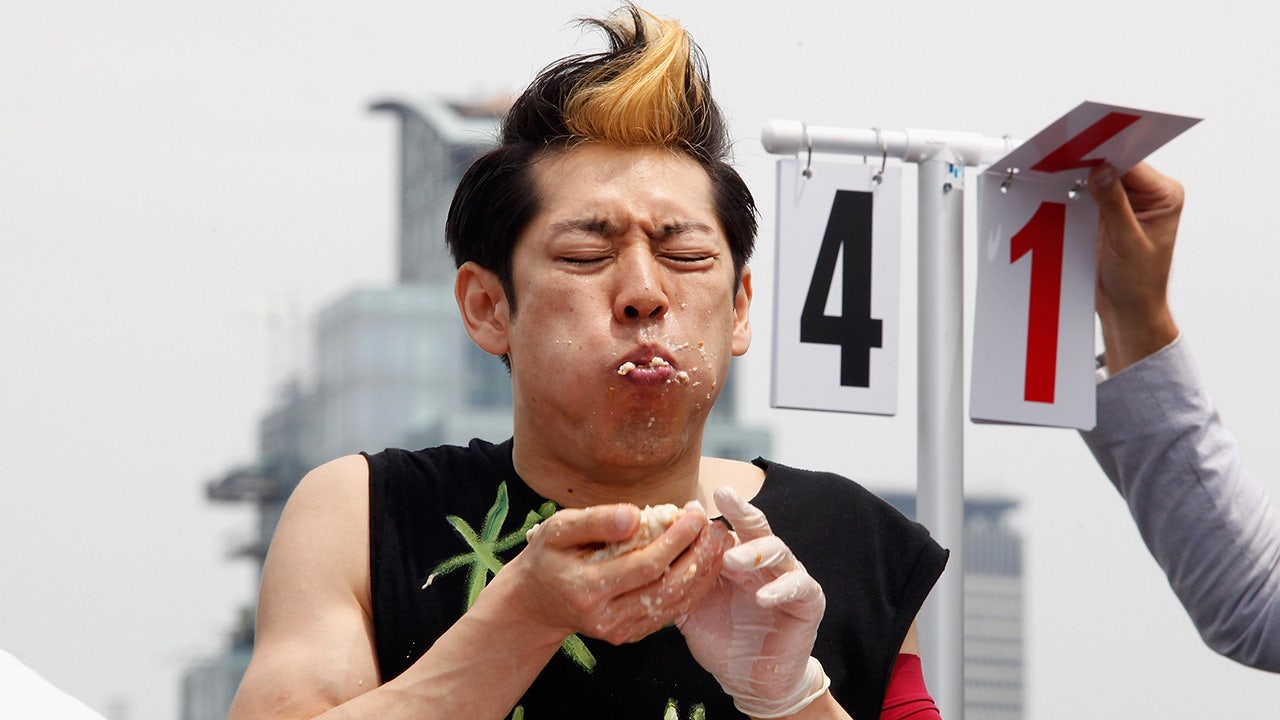
Japanese competitive eater Takeru Kobayashi has announced his retirement in a new Netflix documentary in which the six-time winner of the famous Nathan’s Hot Dog Eating Contest revealed that he no longer has an appetite.
Kobayashi, 46, opened up about his health concerns in the film “Hack Your Health: The Secrets of Your Gut.” He estimated that over the course of his 20-year career, he has eaten around 10,000 hot dogs.
Takeru Kobayashi of Japan sits in exhaustion after downing 44 hot dogs at the annual hot dog eating contest at Coney Island July 4, 2003 in New York City. Kobayashi, who set a world record of 50 1/2 hot dogs in last years contest, asily won again this year. (Chris Hondros/Getty Images)
“I hear people say they’re hungry, and they look very happy after they’ve eaten,” Kobayashi said in the documentary. “I’m jealous of those people because I no longer feel hunger.”
The informational film follows the lives of four individuals, each of which has their own digestive health issues. Kobayashi talks about his lack of appetite, which his wife revealed has led the competitive eater to go days without having a meal.
“Ever since I started this career, I’ve wondered what damage I’ve done to my body,” he said.
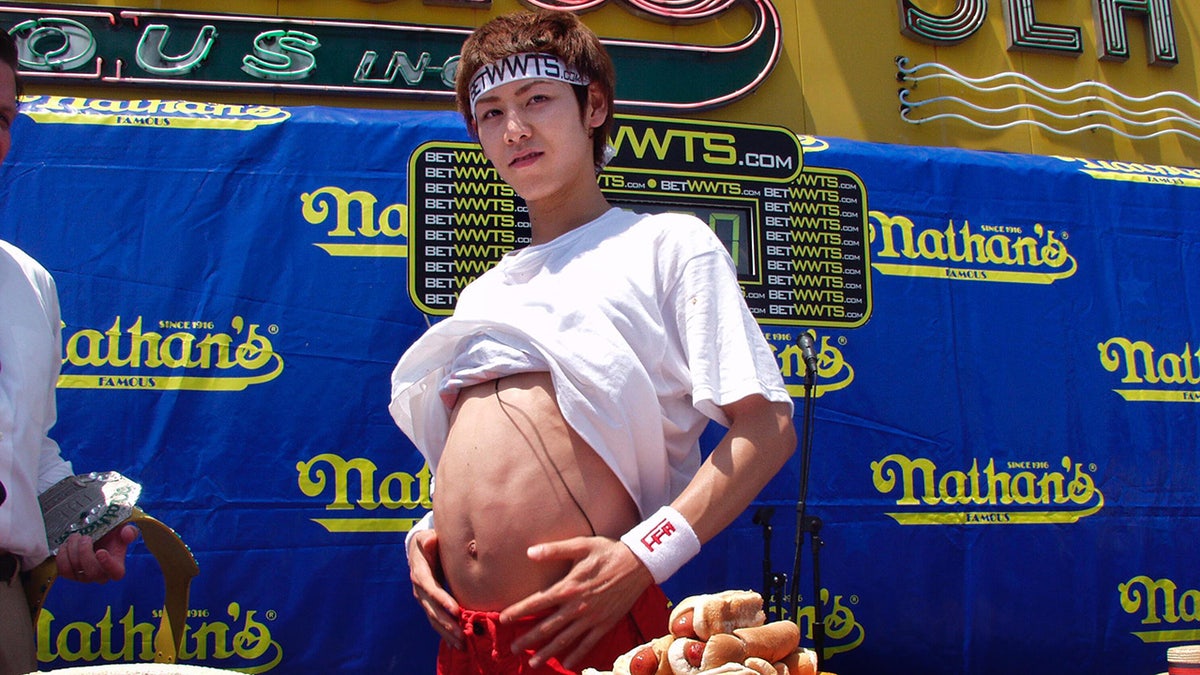
All-time world record holder Takeru Kobayashi of Japan, who ate 50 hot dogs and buns in 12 minutes in 2001, breaks his own record in 2002 by eating 50 1/2 hot dogs and buns. (Mychal Watts/WireImage)
JOEY CHESTNUT WINS MEN’S HOT DOG EATING CONTEST AFTER WEATHER DELAY
After undergoing a series of tests, Kobayashi is informed that while his gut microbiome appeared to be fine, his brain scans were cause for concern, a wake-up call that eventually led to him walking away from the sport. .
“I’ve decided to retire from competitive eating. It’s all I’ve done for the last 20 years. I am worried about what my next step will bring, but I am also excited about my future. I have mixed feelings.”

Competitive eater Takeru Kobayashi challeges 2011 Nathan’s Famous Hot Dog Eating Competition Contestants via satellite at 230 Fifth Avenue on July 4, 2011 in New York City. (Cindy Ord/Getty Images)
While taking a step back, Kobayashi isn’t taking hot dogs off the menu any time soon.
“Throughout my career, what’s influenced me more than competitive eating is the hot dog. I want to create a healthier hot dog by combining it with healthy Japanese ingredients.”
Follow Fox News Digital’s sports coverage on X, and subscribe to the Fox News Sports Huddle newsletter.
Sports
North Hollywood, Banning advance to City Section Division I championship game at Dodger Stadium
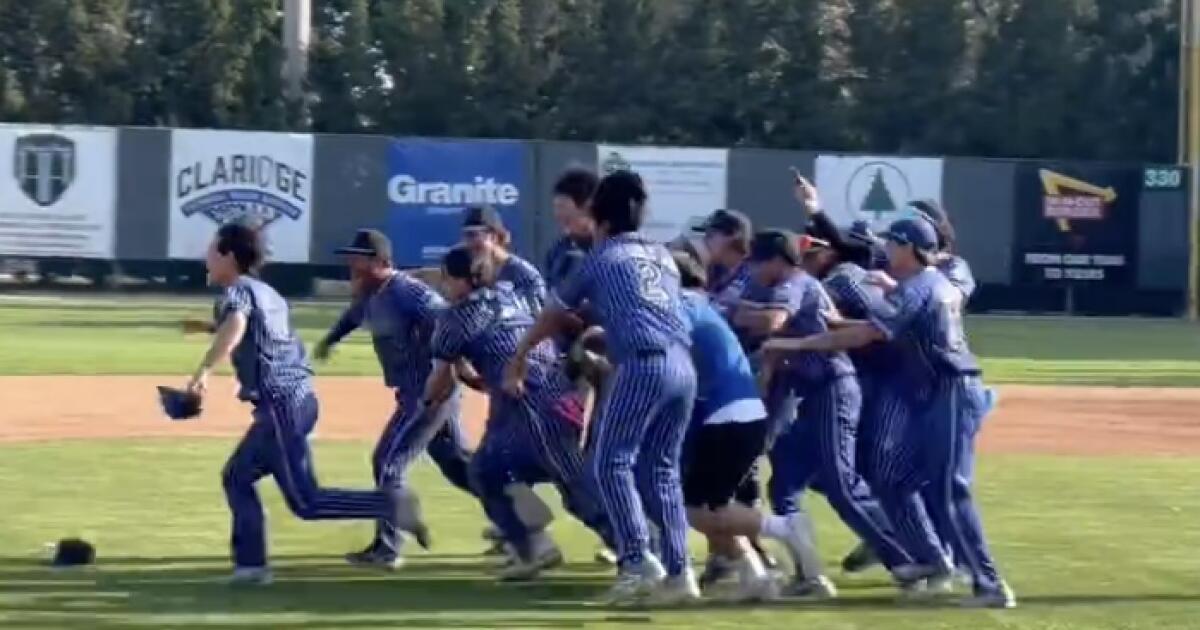
North Hollywood is headed to Dodger Stadium on Saturday to play for a City Section Division I championship.
The Huskies knocked off Chatsworth 6-2 in Wednesday’s semifinals at Stengel Field.
Enoch Yi threw a complete game, striking out seven while giving up two hits. He also had two hits.
A four-run fifth inning broke the game open with the Huskies taking advantage of errors and executing bunts.
North Hollywood will play Banning in Saturday’s 10 a.m. final. It’s a particular accomplishment for a Huskies baseball program that has been without a home field since after the 2019 season while the school underwent a campuswide construction project, including the opening of a new gym.
Banning 5, South East 0: The Pilots turned to the quarterback for the football team, Robert Guerrero, to deliver victory in their Division I semifinal game. Guerrero threw a complete game, giving up two hits while striking out seven and walking none. Angelo Duarte had a two-run single during a four-run second inning.
The Pilots are on their way to Dodger Stadium! 👀⚾️
Banning 5
South East 0
Division I Championship 🏆
Banning vs North Hollywood
Saturday, 10:00 am pic.twitter.com/iIyEd88Whq— CIF LA City Section (@CIFLACS) May 23, 2024
-

 News1 week ago
News1 week agoNevada Cross-Tabs: May 2024 Times/Siena Poll
-

 World1 week ago
World1 week agoPro-Palestinian university students in the Netherlands uphold protest
-

 Politics1 week ago
Politics1 week agoWhite House walks diplomatic tightrope on Israel amid contradictory messaging: 'You can't have it both ways'
-

 Politics7 days ago
Politics7 days agoSouthern border migrant encounters decrease slightly but gotaways still surge under Biden
-

 Politics1 week ago
Politics1 week agoReports of Biden White House keeping 'sensitive' Hamas intel from Israel draws outrage
-

 Politics1 week ago
Politics1 week agoDem newcomer aims for history with primary win over wealthy controversial congressman
-

 World7 days ago
World7 days agoSlovakia PM Robert Fico in ‘very serious’ condition after being shot
-
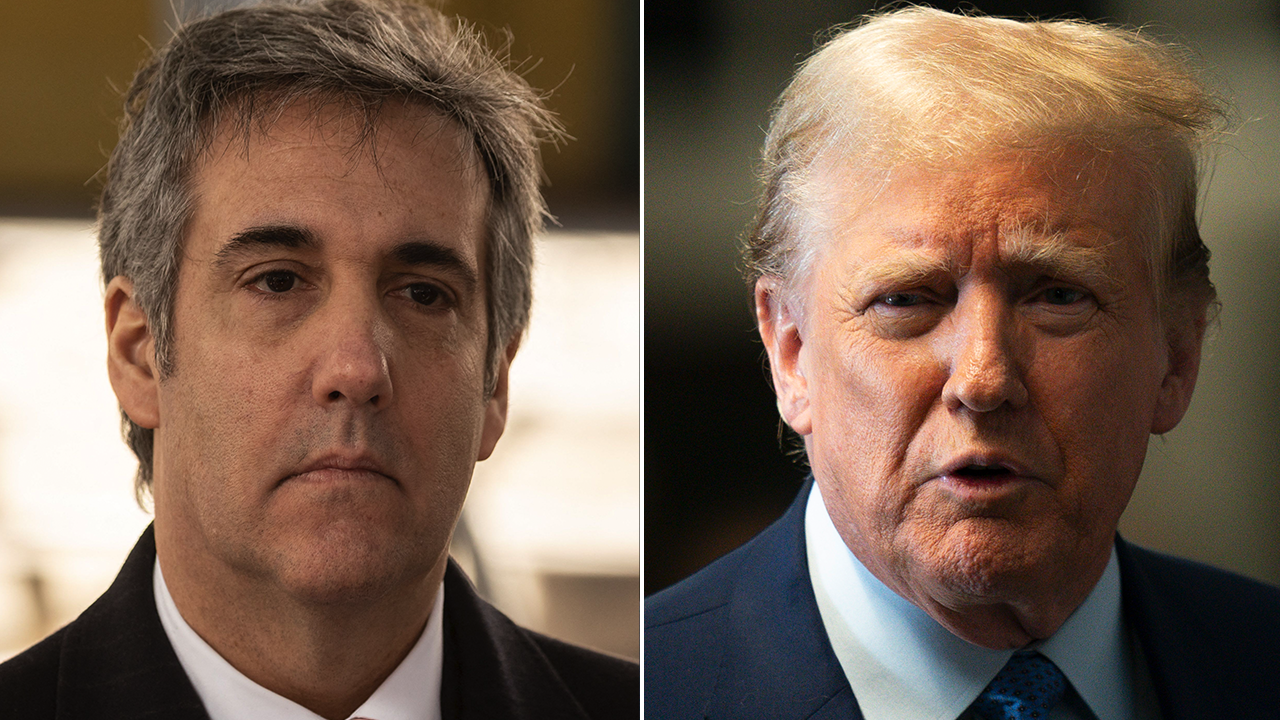
 Politics1 week ago
Politics1 week agoNY v. Trump trial resumes with 'star witness' Michael Cohen expected to take the stand

